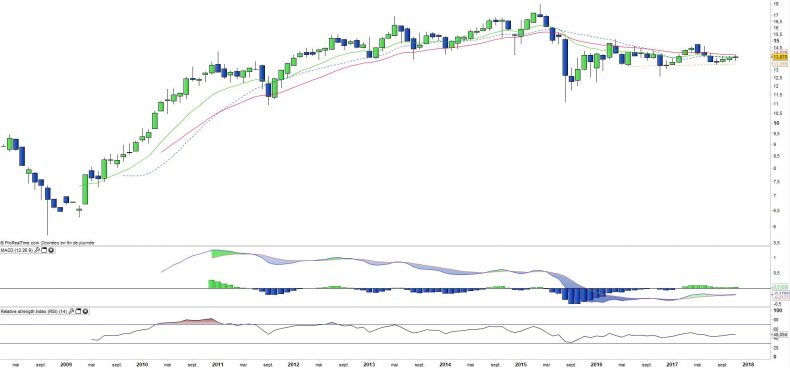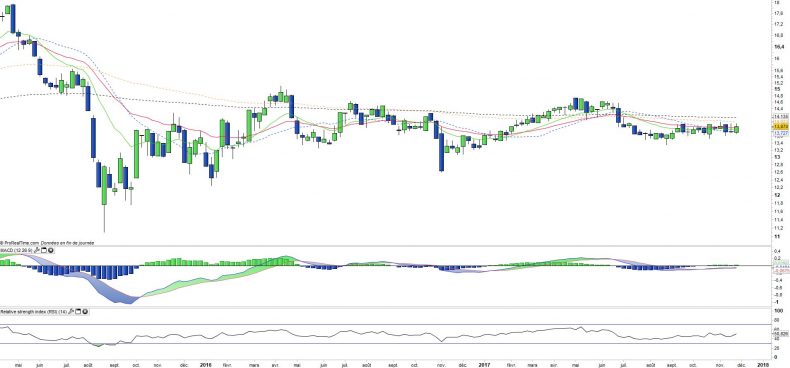Lyxor ETF Malaysia (€) - MAL - 01/12/2017
Short Term strategy : Positive (80%) / trend +
Long Term strategy : Negative (30%) / trend =
Characteristics of the ETF
The ETF MAL (Lyxor UCITS) created in 03/2008 is quoted in euro on Euronext and replicates the index MSCI Malaysia net dividends reinvested (net return).
Shares in the MSCI Malaysia Index are selected to represent 85% of the country's market capitalization, while reflecting the economic diversity of this market. The MSCI Malaysia Index is composed of 41 constituents, and is relatively diversified from a sectoral point of view. This index embeds a risk related to the evolution of the Euro / Ringitt pair related to the economy and the policy of the central banks of the two zones.
The fee of this ETF is 0.65% for an AUM of 32M €. The replication method is indirect (via swap) and there is a dividend capitalization policy
Alternative ETFs: EWM (iShares in USD)
Index & components
The financial sector (banks and insurance) accounts for 31% of the index's capitalization, industry 14.5%, utilities 14.8% and telecoms 9.8%.
This tracker presents a currency risk linked to the exposure of the MSCI Malaysia Index (quoted in US $), resulting from the evolution of the reference currency, the Malaysian ringgit.
Malaysia already has one of the highest standards of living in Southeast Asia and a low unemployment rate (below 3%). However, the current Prime Minister Najib Razak aims, through a new economic model based on innovation and technology to double per capita income by 2020.
Malaysia is ranked among the world's leading producers of oil. palm, cocoa and rubber, but is also a leading exporter of tropical timber. Malaysia has successfully developed its commodity-based economy (the export of rubber and tin, large reserves of oil and gas, copper and bauxite). The industry has taken over and contributes about 36% of GDP and employs more than 27.4% of the population, Malaysia has become one of the world's largest exporters of semiconductor devices and the government has ambitious plans to make the country a leading manufacturer and developer of technology products, including software. Malaysia is an important destination for offshoring component manufacturing after China and India and has attracted significant foreign investment that has played a major role in the transformation of the economy.
The tertiary sector employs the majority of Malaysians (more than 60%) and accounts for 55% of the GDP thanks, in particular, to the tourism sector, indeed Malaysia has become one of the main tourist destinations of Southeast Asia.
The country is operating in a region with high growth potential and should capitalize on its educated population and an expanding middle class. Malaysia's GDP is around $ 300bn (the equivalent of Denmark or South Africa) for a population of 30 million, and 4.6% growth is expected in 2017.The economy is diversified and seems to be gaining in value, with a growing weight of technology like Singapore.
Kuala Lumpur adopts a cautious and pragmatic diplomacy, projecting the image of a moderate and modern Muslim country, as evidenced by its election to the UN Security Council in 2015-2016.
Latest developments
After a year of sharp decline in 2015 (-12%) and stabilization in 2016 (-2%), the index rose moderately by 4.4% in 2017 due to a stabilization of raw materials.
Malaysia's economy is broadly diversified (industrial base, agriculture, service sector dynamism) even though it still relies heavily on large hydrocarbon resources. It is the second largest producer of crude oil in Southeast Asia (after Indonesia) and the third largest exporter of liquefied natural gas. The index and the currency therefore remain highly correlated with oil prices.
Prime Minister Najib Razak, head of government since 2009, is a favorite to win the next general election, scheduled for 2018, but that could be anticipated. The slow tightening of the US Federal Reserve's monetary policy is helping to contain capital outflows and the banking sector remains sufficiently capitalized and liquid.
The renewal of the OPEC agreements until the end of 2018, which aims to reduce the excess supply on the market, is good news, likely to support crude prices, which should benefit the Malaysian economy.
Monthly data
The monthly chart shows a long-term trend that is no longer bullish since early 2015, in the wake of the decline in commodities and especially oil. Prices have stabilized, building on the EMA100 which serves as a main support line. The last bottoms tend to be in a rising phase and the prices are now at the same level as the monthly moving averages 13 E and 26 E, but have not yet been able to cross them. These are flat as is the MACD, which encourages patience while waiting for a real bullish signal.
Weekly data
On the weekly chart, we can see the same hesitation as on the long-term charts. This week's candlestick shows a new attempt to cross moving averages, but this will have to be confirmed, which has not been the case for the moment. The main resistance is formed by the EMA100 located at € 14 and must be frankly exceeded to convince that a bullish movement is being put in place.
ETF Objective
MAL is a UCITS compliant ETF that aims to track the benchmark index MSCI Malaysia Net TR (41 companies)
Characteristics
| Inception date | 11/03/2008 |
| Expense ratio | 0,65% |
| Benchmark | MSCI Malaysia Net Total Return |
| Ticker | MAL |
| ISIN | FR0010397554 |
| Currency | € |
| Exchange | Euronext Paris |
| Assets Under Management | 33 M€ |
| Dividend | Capitalization |
| PEA (France) | No |
| SRD (France) | Yes |
| Currency risk | Yes |
| Number of Holdings | 41 |
| Risk | 4/5 |
Country Breakdown
| Malaysia | 100% |
Sector Breakdown
| Financials | 31% |
| Industrials | 15% |
| Utilities | 15% |
| Telecom Services | 10% |
| Consumer discretionary | 9% |
| Consumer Staples | 9% |
| Energy | 4% |
| Others | 7% |
Top Ten Holdings
| Public Bank Berhad | 13% |
| Tenaga Nasional BHD | 11% |
| Malayan Banking BHD | 7% |
| CIMB Group Holdings Berhad | 5% |
| Kumpulan Sime Darby BHD | 5% |
| Genting BHD | 4% |
| Petronas Chemical Group BHD | 4% |
| Genting Malaysia BHD | 3% |
| Axiata Group Berhad | 3% |
| DIGI.com BHD | 3% |


